
The transport system of Finland is well-developed. Factors affecting traffic include the sparse population and long distance between towns and cities, and the cold climate with waterways freezing and land covered in snow for winter.

Helsinki is the capital and most populous city in Finland. It is on the shore of the Gulf of Finland and is the seat of southern Finland's Uusimaa region. About 675,000 people live in the municipality, with 1.25 million in the capital region and 1.58 million in the metropolitan area. As the most populous urban area in Finland, it is the country's most significant centre for politics, education, finance, culture, and research. Helsinki is 80 kilometres (50 mi) north of Tallinn, Estonia, 360 kilometres (220 mi) north of Riga, Latvia, 400 kilometres (250 mi) east of Stockholm, Sweden, and 300 kilometres (190 mi) west of Saint Petersburg, Russia. Helsinki has significant historical connections with these four cities.
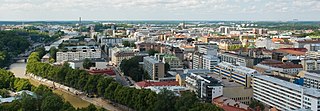
Turku is a city in Finland and the regional capital of Southwest Finland. It is located on the southwestern coast of the country at the mouth of the River Aura. The population of Turku is approximately 202,000, while the metropolitan area has a population of approximately 311,000. It is the 6th most populous municipality in Finland, and the third most populous urban area in the country after Helsinki and Tampere.

VR-Group Plc, commonly known as VR, is a government-owned railway company in Finland. VR's most important function is the operation of Finland's passenger rail services with 250 long-distance and 800 commuter rail services every day. With 7,500 employees and net sales of €1,251 million in 2017, VR is one of the most significant operators in the Finnish public transport market area.

Television was introduced in Finland in 1955. Color television started in 1969 and was introduced gradually, with most programs in color by the late 1970s. All terrestrial analogue stations stopped broadcasting on 1 September 2007 after the introduction of digital television; cable providers were allowed to continue analog broadcasting in their networks until 1 March 2008.
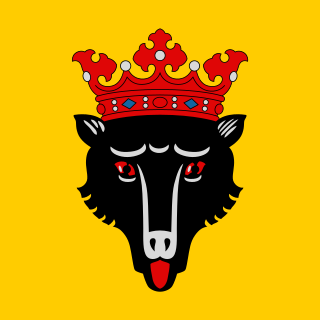
Pori is a city in Finland and the regional capital of Satakunta. It is located on the west coast of the country, on the Gulf of Bothnia. The population of Pori is approximately 83,000, while the sub-region has a population of approximately 129,000. It is the 10th most populous municipality in Finland, and the eighth most populous urban area in the country.

Gatorade Center is a multi-functional indoor arena in the district of Artukainen in Turku, Finland. Opened in November 1990, it can hold up to 11,820 spectators for ice hockey games.

The Finnish railway network consists of a total track length of 9,216 km (5,727 mi). The railways are built with a broad 1,524 mm track gauge, of which 3,249 km (2,019 mi) is electrified. Passenger trains are operated by the state-owned enterprise VR that runs services on 7,225 km (4,489 mi) of track. These services cover all major cities and many rural areas, though the coverage is less than the coverage provided by the bus services. Most passenger train services originate or terminate at Helsinki Central railway station, and a large proportion of the passenger rail network radiates out of Helsinki. VR also operates freight services. Maintenance and construction of the railway network itself is the responsibility of the Finnish Rail Administration, which is a part of the Finnish Transport Agency. The network consists of six areal centres, that manage the use and maintenance of the routes in co-operation. Cargo yards and large stations may have their own signalling systems.
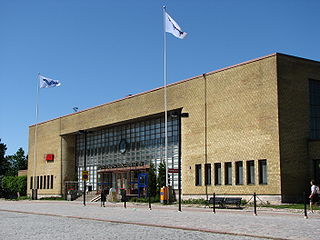
Turku Central Station is a railway station in the VII District of Turku, Finland. It has VR services to Helsinki and towards Joensuu. The station serves approximately a million passengers annually.
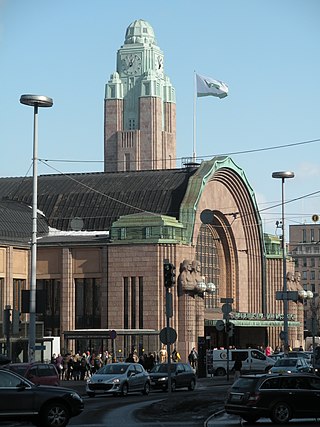
Helsinki Central Station (HEC) is the main station for commuter rail and long-distance trains departing from Helsinki, Finland. The station is used by approximately 400,000 people per day, of whom about 200,000 are passengers. It serves as the terminus for all trains in the Helsinki commuter rail network, as well as for all Helsinki-bound long-distance trains in Finland. The Rautatientori metro station is located in the same building.

Pasila station is a railway station in Helsinki, Finland, approximately 3.5 kilometres (2.2 mi) north of Helsinki Central. It is the second busiest railway station in Finland, after Helsinki Central, and takes up a large part of the district of Pasila. The station was first opened in 1862 along the Finnish Main Line. The current station building opened in 2019.
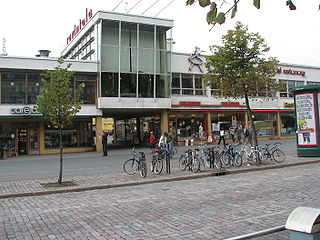
Lasipalatsi is a functionalist office building designed in the 1930s, located on Mannerheimintie in the Kamppi district of Helsinki, Finland. Lasipalatsi is one of Helsinki's most notable functionalist buildings.

The Great Fire of Turku was a conflagration in the city of Turku in 1827. It is still the largest urban fire in the history of Finland and the Nordic countries. The city had faced several large fires before, including an especially devastating fire in 1681.

Leppävaara is a district of Espoo, a city in Finland. The Rantarata rail line and the Ring Road I, the busiest road in Finland, cross in Leppävaara, thus making it a major traffic hub in the Greater Helsinki region. The Sello Shopping Centre is also located in Leppävaara.

Kupittaa railway station is located in the Kupittaa district of Turku, Finland. The station is located about three kilometres from the Turku Central railway station in the immediate vicinity of the Turku Science Park. All trains between Helsinki and Turku stop at Kupittaa. However, due to construction work between here and Turku, Kupittaa is the terminus of the min from Helsinki from August 2022 until the end of 2024. Signalling is handled from Turku Central railway station. The station has bus connections to Föli lines 32, 42, 58 and 110.

The Sm3 Pendolino is a class of high-speed body-tilting trains operated by VR Group. It is a member of the Pendolino train family; its design is based on the ETR 460. The first two trainsets were assembled in Finland by Rautaruukki-Transtech in the mid-1990s. The rest of the series of eighteen EMUs were built by Fiat Ferroviaria between 2000 and 2006. The trains serve most of Finland's major cities such as Helsinki, Turku, Oulu and Joensuu with a maximum speed of 220 km/h (140 mph), although this speed is only attained between Kerava and Lahti. The train has a power output of 4,000 kW (5,400 hp) and weighs 328 tonnes.

Although Finland has no dedicated high-speed rail lines, sections of its rail network are capable of running speeds of up to 220 km/h (137 mph). The Finnish national railway company VR operates tilting Alstom Pendolino trains. The trains reach their maximum speed of 220 km/h (137 mph) in regular operation on a 75.7 km (47.0 mi) route between Kerava and Lahti. This portion of track was opened in 2006. The trains can run at 200 km/h (124 mph) on a longer route between Helsinki and Seinäjoki and peak at that speed between Helsinki and Turku. The main railway line between Helsinki and Oulu has been upgraded between Seinäjoki and Oulu to allow for trains to run at speeds between 160 km/h (99 mph) and 200 km/h (124 mph). Other parts of the Finnish railway network are limited to lower speed.

The Voice of Finland is a Finnish reality singing competition and local version of The Voice first broadcast as The Voice of Holland. The series premiered on Nelonen on 30 December 2011 and the first season concluded in April 2012. A second season started on 4 January 2013 and concluded on 26 April 2013. The series was further renewed for a third season, which premiered on 3 January 2014.
The Voice of Finland is the sixth season of the Finnish reality singing competition based on The Voice format. The season premiered on Nelonen on January 6, 2017. The live final is scheduled on April 14, 2017.
The Museum of History and Future is a museum planned for Turku, which will open to the public in its entirety in 2030. The purpose of the interactive and experiential museum is to present the history of both Finland and Turku and to combine the different characteristics of museums, science centers and theme parks.





















